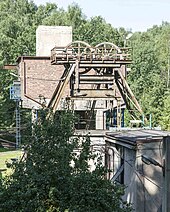Kopalnia Węgla Kamiennego Rokitnica
The Castellengo mine (Polish: Kopalnia Węgla Kamiennego Rokitnica ) is a coal mine north of the Biskupice district of Zabrze , Poland, which is still partially privately extracted .
history
Castellegno mine
The coal fields Castellengo, Leithold, Anna-Maria I and Valentin in Biskupitz with a total rights of 3.47 km² (according to other sources 3.52 km²) were awarded to Count Ballestrem in the 1850s and 1860s . A mine field and later also the entire colliery got its name from the ancestral seat of the north Italian family of Count Ballestrero di Castellengo from Piedmont . Initially, some parts of the field were leased, others remained unscratched, before in 1890 an independent shaft system with the four shafts of Tante Anna (380 m; production shaft of 375 m bottom; Pochhammer seam; also water drainage), Toppolzan (255 m; production shaft to 250 m bottom; Schuckmann seam) , President of the Reichstag 384 m (cable ride) and Bergrat Pieler 261 m (extending weather and material shaft; location near the northern divide). The reason for the construction of a new mine was that the production of the mines owned by Ballestrem in Ruda ( Brandenburg , Wolfgang and Graf Franz ) could not be increased any further. Coal production increased from an initial 2,973 t (1901) to 822,343 t in 1912. Soon there was a cable car that carried the coal extracted from Castellengo to the Bobrek coking plant .
In 1927 the Ballestrem coal fields and pits were combined in the Concordia union , which was founded as a holding company in 1922 after the division of Upper Silesia . Concordia held 78% of the Kuxe in the Castellengo Defense Union , the merger of Castellengo with the Abwehrgrube , the remaining 22% belonged to upper needs. In 1926, as a result of the division of Silesia, Oberbedarf itself was part of the joint venture United Oberschlesische Hütten AG (VOH; also Oberhütten), in which Friedrich Flick owned the majority of the shares.
CHP Rokitnica
In 1945 the Castellengo mine was renamed Rokitnica; a district of Zabrze of the same name is located north-north-west of the mine.
Because a streamlining of coal production in the north of Zabrze had been considered early on, during the Second World War the sinking of a new central shaft only approx. 400 m west of the old Castellengo facilities was started and provided with a huge shaft hall and a new processing facility. The new Gigant shaft with a depth of 875 m (later 1300 m), which supports a double trestle as a headframe, could only be put into operation on December 4, 1953. Originally the facility called Rokitnica II was supposed to be an independent mine, but this never happened. Rather, the pits all around were merged in quick succession.
First in the same year the Franciszek double shaft belonging to Hedwigswunsch / Pstrowski was added to the Roktnica mine, then on October 1, 1960 the merger with the Abwehrgrube / Mikulczyce mine under the name Mikulczyce-Rokitnica took place. On January 1, 1970, the Ludwigsglück-Concordia mine to the west was added and the name was simplified back to Rokitnica. On January 1st 1973 there was another amalgamation in the north of Zabrze, this time with Hedwigswunsch / Jadwiga / Pstrowski. This composite mine, which thus included all the mines in the north of Zabrze, bore the name of this communist "hero of work" with Pstrowski .
Funding figures
1913: 839,207 t; 1938: 2.28 million t; 1970: 2.82 million t
present
The three remaining shafts, Gigant , Staszic (formerly Topplozan; conveyor shaft) and Mikołaj ( extending weather shaft) are still in use today. The Gigant shaft is currently still operated by the company CZOK ( Centralny Zakład Odwadniania Kopalń ) for the dewatering of Countess Johanna / Bobrek and Bielschowitz / Bielszowice . Since 2008, the private company Siltech has been mining coal with economic success again and extracting it through the Staszic shaft. Mikołaj, to the south-west, is an extending weather shaft with a small headframe.
swell
- Jerzy Jaros: Słownik historyczny kopalń węgla na ziemiach polskich. Katowice 1984.
- Kurt König: The coal mining in Upper Silesia from 1945–1955. Scientific contributions to the history and regional studies of Eastern Central Europe. Published by the Johann Gottfried Herder Institute. Marburg 1958.
- The Silesian Mines 1938. Published by the Prussian Mining Authority in Breslau. Publishing house NS-Druckerei, Breslau.
- Yearbook for the Upper Mining District Wroclaw. Phoenix Publishing House. Katowice, Breslau, Berlin. 1913. Digitized version at http://www.dbc.wroc.pl/dlibra/publication?id=3349&tab=3 before (last accessed on May 5, 2015)
- Johann Hermann: From the Castellengogrube to the Siltech mine via the Rokitnica, Pstrowski, Jadwiga mines . Hamm 2016, ISBN 978-3-00-052293-2 .
Web links
- 43 Flötz maps (sic) of the Upper Silesian coal basin . JPG files showing field boundaries, seams and manholes after the inventory from 1902 in excellent quality. These cards were made by the “Verlag von Priebatsch's Buchhandlung. Breslau ”published.
- Numerous informative photos of the current state of Gigant and Staszic can be found on the website http://zabrze.fotopolska.eu/Zabrze/b72176,Szyb_Gigant.html (last accessed on September 25, 2015)
Coordinates: 50 ° 20 ′ 31.4 " N , 18 ° 49 ′ 51.4" E



